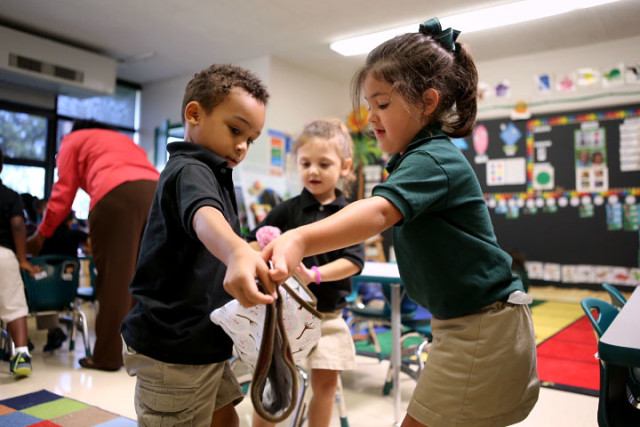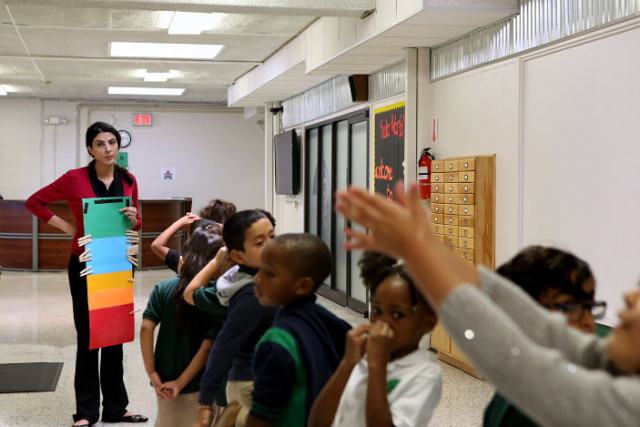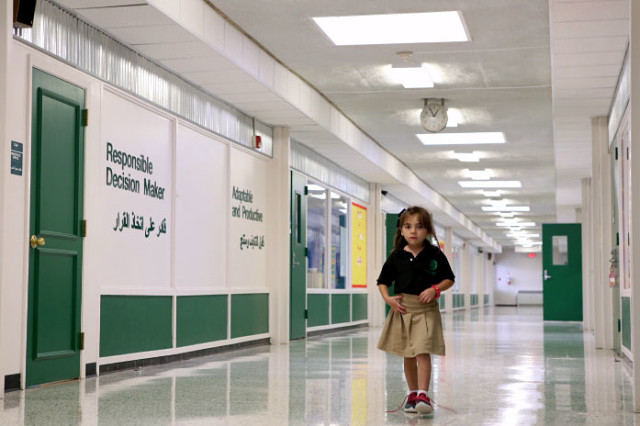Learning Arabic Begins Early for Houston Magnet School Students
By Adam Hamze
Reporting Texas

Adrian Malveaux (left), Elizabeth Akkam and Valentina Murillo fold a blanket after nap time in their pre-kindergarten class at the Arabic Immersion Magnet School in Houston. Thalia Juarez/Reporting Texas
HOUSTON — As the children sit cross-legged on the floor, singing in Arabic, their teacher calls on them, one by one. She asks them about their day – in Arabic. Without hesitation, the 4- and 5-year-olds respond in English, comprehending a language foreign to most of them only a few weeks earlier.
“In the first week of school, the kids could already count to 10,” said Kate Adams, principal of the public Arabic Immersion Magnet School in northwest Houston. “We do this assembly every morning., I’ll call on a kid randomly in the audience, and they want to get up, and they can do the alphabet, and they want to sing and count in Arabic. It doesn’t even faze them.”
In classrooms filled with posters featuring Arabic words and numbers, children learn what’s considered one of the most difficult languages because of its complex grammar, difficult pronunciation and an alphabet in which one letter may have four different forms. AIMS is the first school of its kind in Texas and one of a few in the nation. Proponents say immersion schools enhance children’s cultural understanding and that Arabic immersion offers students unique and marketable skills, as well as a more nuanced view of the Middle East.
The magnet school functions much like a standard elementary school. The curriculum focuses on four subject areas — English and social studies, taught in English, and math and science, taught in Arabic. The 132 students, 44 pre-K and 88 kindergarten, learn from a staff of seven teachers, many of whom are native Arabic speakers.
“It’s amazing for me to see that this time last year, this school didn’t exist,” said Adams, who learned some Arabic as a child, when her family lived in Cairo. “Now it’s finally real, and it’s happening, and it’s successful.”
Students come from a variety of racial and ethnic backgrounds, and most are from families that do not speak Arabic at home. The school had three applications for every seat, Adams said.

Imene Mechkene lines up her kindergarten class for a bathroom break at the Arabic Immersion Magnet School in Houston. Thalia Juarez/Reporting Texas
Mia Jamal said she wanted her son, Khalid, a kindergartener at AIMS, to learn in a challenging environment and develop mental flexibility that would help him throughout his education.
“He loves it. He comes home and he practices Arabic with me, and I don’t speak a lick of Arabic,” said Jamal, who is Mexican-American. “Mental flexibility is so important for a child to have because it helps you deal with different situations. It sets him up to say, ‘I know one of the most difficult languages in the world, so I can pretty much learn anything.’ Just the fact that his brain will work differently than most people is all we wanted from him.”
About 1,000 of 215,000 students in HISD speak Arabic, making it the third most common language spoken at home, behind English and Spanish. About 24,300 people in Houston speak Arabic, nearly half of the statewide total, according to the 2014 U.S. Census.
The push to create the school was supported by Houston’s Arabic-speaking community and the sprawling energy industry, said Farhan Shah, director of global education for the Houston district. Many Houston companies do business in the Middle East and said the energy industry needs more fluent Arabic speakers, according to Shah. The HISD Board of Education voted unanimously to approve the school in November 2014.
Language immersion programs first surfaced in the United States in the 1970s. Immersion programs for young children make them better critical thinkers, with higher scores on standardized testing, according to the Center for Advanced Research on Language Acquisition. Younger students have a higher capacity to master difficult languages than adults do, according to The American Council on the Teaching of Foreign Languages.
“When our kids are learning, it’s almost second nature to them, because when you’re learning foreign language as an adult, you’re learning through the lens of whatever language you speak,” Adams said. “When you’re learning about grammar when you’re 4 or 5, you don’t know you’re specifically learning about grammar – you’re just learning.”
Emran El-Badawi, the director of the Arab Studies Program at the University of Houston, has been working with the district since 2012 to create the school, primarily helping to find qualified teachers. Arab fluency can open up future job opportunities for students in the energy and finance industries and government, but he said the program has other benefits.
“By empowering these students to know at least a second language, they’re going to be more competitive on the job market,” El-Badawi said. “They’re going to be more sensitive as human beings, and they’re going to make better decisions about the world that we live in.”
He said he believes the media has associated Arabic with a negative stigma by exclusively focusing on conflict and terrorism when discussing the Middle East, and the early language education is a way to neutralize ignorance.
“The middle ground where people sit at a table and talk is being continuously eroded every day. It’s scary and disheartening,” El-Badawi said. “That’s what makes these projects particularly important, because you’re not just learning about the language, you’re learning about culture.”

Jesi Garcia, a kindergarten student, walks down a hallway in the Arabic Immersion Magnet School in Houston. Thalia Juarez/Reporting Texas
The school encountered some opposition on the first day of class, when 30 adults holding American flags and anti-Islam signs held a protest outside of the school. They have not returned.
Current school systems do not expose students to enough foreign languages and cultures, according to Shah, which he said he believes is crucial for both educational and personal growth.
“There is a trend nationally towards nationalism, which has real dangers for us as a society and in our education systems,” Shah said. “For myself and also for my team, and I would say HISD’s administration at large, we kind of work against that.”
The school is about more than language, he said.
“We’re opening up horizons.”